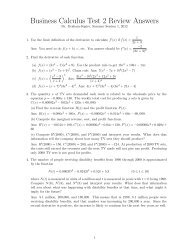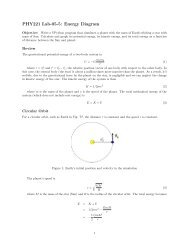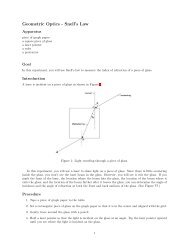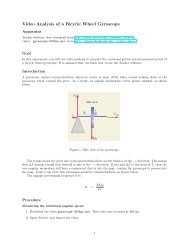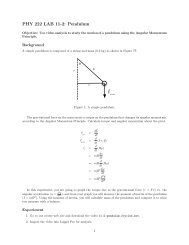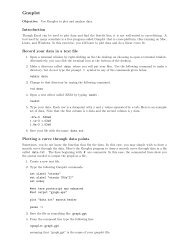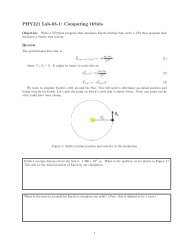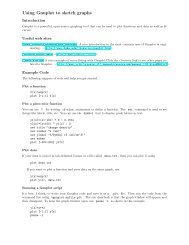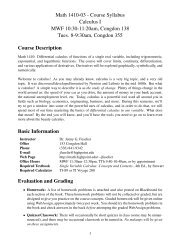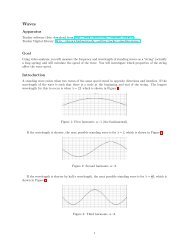Physics 1520, Fall 2011
Physics 1520, Fall 2011
Physics 1520, Fall 2011
Create successful ePaper yourself
Turn your PDF publications into a flip-book with our unique Google optimized e-Paper software.
<strong>Physics</strong> <strong>1520</strong>, <strong>Fall</strong> <strong>2011</strong><br />
Quiz 1, Form: A<br />
Name:<br />
Date:<br />
Numeric answers must include units. Sketches must be labeled.<br />
Section 1.<br />
Multiple Choice<br />
1. In the lab, you set up a vertical mass-spring system. You pull the mass down and release it from rest.<br />
It oscillates with a period of 2.0 s. What is its frequency<br />
(a)<br />
(b)<br />
(c)<br />
(d)<br />
(e)<br />
π Hz<br />
0.25 Hz<br />
0.5 Hz<br />
2.0 Hz<br />
4.0 Hz<br />
Questions 2–4: A simple harmonic oscillator has the x(t) graph shown below.<br />
2. What is the period<br />
(a) 1.2 s<br />
(b) 2.0 s<br />
(c) 1.7 s<br />
(d) 4.0 s<br />
(e) 2.2 s<br />
3. What is the amplitude<br />
(a) -10 cm<br />
(b) 2.5 cm<br />
(c) 5 cm<br />
(d) 10 cm<br />
(e) 20 cm<br />
4. What is the first clock reading t when the velocity of the object is zero<br />
(a) 0.2 s<br />
(b) 1.7 s<br />
(c) 0<br />
(d) 1.2 s<br />
(e) 0.7 s<br />
1
5. Four different oscillators are shown below.<br />
Which oscillator has the greatest angular frequency ω<br />
(a)<br />
(b)<br />
(c)<br />
(d)<br />
(e)<br />
A<br />
B<br />
C<br />
D<br />
They have the same angular frequency.<br />
6. A bullwhip is thick at the handle and thin at the end. Thus, its linear density µ is larger at the handle<br />
and smaller at the end. As a wave pulse travels down the whip, its speed v will<br />
(a)<br />
(b)<br />
(c)<br />
decrease<br />
increase<br />
stay the same<br />
7. Blue light has a shorter wavelength than red light. Which color as a higher frequency<br />
(a)<br />
(b)<br />
(c)<br />
blue<br />
red<br />
neither, because they have the same frequency<br />
8. What determines the speed of a wave in a medium<br />
(a)<br />
(b)<br />
(c)<br />
(d)<br />
(e)<br />
the frequency of the wave<br />
the wavelength of the wave<br />
the amplitude of the wave<br />
the power of the wave<br />
the properties of the medium<br />
9. In a class demo, the speaker emitted a sound wave of frequency 300 Hz. What was the wavelength of<br />
the wave in air (v air ≈ 340 m/s)<br />
(a)<br />
(b)<br />
(c)<br />
(d)<br />
(e)<br />
0.88 m<br />
0.25 m<br />
40 m<br />
1.1 m<br />
0.0033 m<br />
2
10. Which of the following increases when a sound becomes louder<br />
(a)<br />
(b)<br />
(c)<br />
(d)<br />
(e)<br />
frequency<br />
wavelength<br />
amplitude<br />
period<br />
velocity<br />
11. Is it ever possible for a sound wave in air to overtake and pass another<br />
(a)<br />
(b)<br />
(c)<br />
yes<br />
no<br />
It depends on the wavelength and frequency of the waves. Sometimes yes, and sometimes no.<br />
12. You and a friend hold the ends of a long spring. One of you creates a transverse wave pulse which<br />
travels down the spring at a speed of 2.0 m/s. If you double the tension in the spring and generate a<br />
second wave pulse, its speed will be<br />
(a)<br />
(b)<br />
(c)<br />
(d)<br />
(e)<br />
2.8 m/s.<br />
1.4 m/s.<br />
4.0 m/s.<br />
8.0 m/s.<br />
the same, 2.0 m/s.<br />
13. (TRUE or FALSE): You are generating traveling waves on a stretched string by wiggling one end.<br />
If you suddenly begin to wiggle more rapidly, you will cause the waves to travel faster down the<br />
string.<br />
(a)<br />
(b)<br />
TRUE<br />
FALSE<br />
14. The intensity of sound due to a jack hammer is 2.0 W/m 2 at a distance of 2 m from the jack hammer.<br />
If you instead stand at twice this distance from the jack hammer, the intensity of the sound will be<br />
(a) 0.25 W/m 2<br />
(b) 0.5 W/m 2<br />
(c) 1.0 W/m 2<br />
(d) 4.0 W/m 2<br />
(e) the same, 2.0 W/m 2<br />
15. What is the intensity level in decibels of a sound whose intensity is 10 −7 W/m 2 <br />
(a)<br />
(b)<br />
(c)<br />
(d)<br />
(e)<br />
20 dB<br />
30 dB<br />
40 dB<br />
50 dB<br />
60 dB<br />
3
16. A sound source (the dot on the left) travels toward a stationary listener (the dot on the right). Wavecrests<br />
from the source are shown.<br />
Does the listener measure a shorter wavelength or longer wavelength than when the sound source is<br />
not moving<br />
(a)<br />
(b)<br />
(c)<br />
shorter wavelength<br />
longer wavelength<br />
neither; it will be the same<br />
Questions 17–18: You set up a standing wave on a string as shown below.<br />
17. Which harmonic is this<br />
(a) m=1<br />
(b) m=2<br />
(c) m=3<br />
(d) m=4<br />
(e) m=5<br />
18. How many nodes are there<br />
(a) zero<br />
(b) 1<br />
(c) 2<br />
(d) 3<br />
(e) 4<br />
4
Quesitons 19–20: The graph below shows the pressure as a function of position for a sinusoidal, longitudinal<br />
standing wave in a pipe.<br />
2<br />
pressure vs. x for a sinusoidal standing sound wave in pipe<br />
1.5<br />
1<br />
p (arbitrary units)<br />
0.5<br />
0<br />
-0.5<br />
-1<br />
-1.5<br />
-2<br />
0 0.2 0.4 0.6 0.8 1<br />
x (m)<br />
19. Evidently,<br />
(a)<br />
(b)<br />
(c)<br />
(d)<br />
the pipe is open on both ends.<br />
the pipe is closed on both ends.<br />
the pipe is open on the left end and closed on the right end.<br />
the pipe is closed on the left end and open on the right end.<br />
20. For standing sound waves in the pipe in the previous question, the wavelengths are λ = 4L m , where<br />
m = 1, 3, 5, .... Which harmonic is shown in the graph<br />
(a) 1<br />
(b) 3<br />
(c) 5<br />
(d) 7<br />
(e) 9<br />
5
Section 2.<br />
Problem Solving<br />
21. A standing wave is created on a string that is fixed on both ends and is 0.5 m long.<br />
(a) Sketch a graph of y(x) for the first harmonic (i.e. the fundamental). What is the wavelength<br />
(b) Sketch a graph of y(x) for the second harmonic. What is the wavelength<br />
(c) If the string’s tension is 100 N and its mass per unit length is 2.5 g/m, what is its fundamental<br />
frequency (Be sure to convert g/m to kg/m.)<br />
22. Suppose that you have a spring of stiffness 16 N/m, and you hang a 0.25 kg mass on the spring. You<br />
pull it down 0.04 m from equilibrium, and you release it from rest.<br />
(a) What is its angular frequency ω<br />
(b) What is the total energy of the oscillator<br />
(c) If you double the amplitude by pulling it down 0.08 m from equilibrium and releasing it from rest,<br />
what will be the angular frequency (If it stays the same, then explain why in words.)<br />
6
Answer Key for Exam A<br />
Section 1.<br />
Multiple Choice<br />
1. (c)<br />
2. (b)<br />
3. (d)<br />
4. (e)<br />
5. (d)<br />
6. (b)<br />
7. (a)<br />
8. (e)<br />
9. (d)<br />
10. (c)<br />
11. (b)<br />
12. (a)<br />
13. (b)<br />
14. (b)<br />
15. (d)<br />
16. (a)<br />
17. (c)<br />
18. (e)<br />
19. (d)<br />
20. (c)<br />
1
Section 2.<br />
Problem Solving<br />
21.<br />
22.<br />
2



